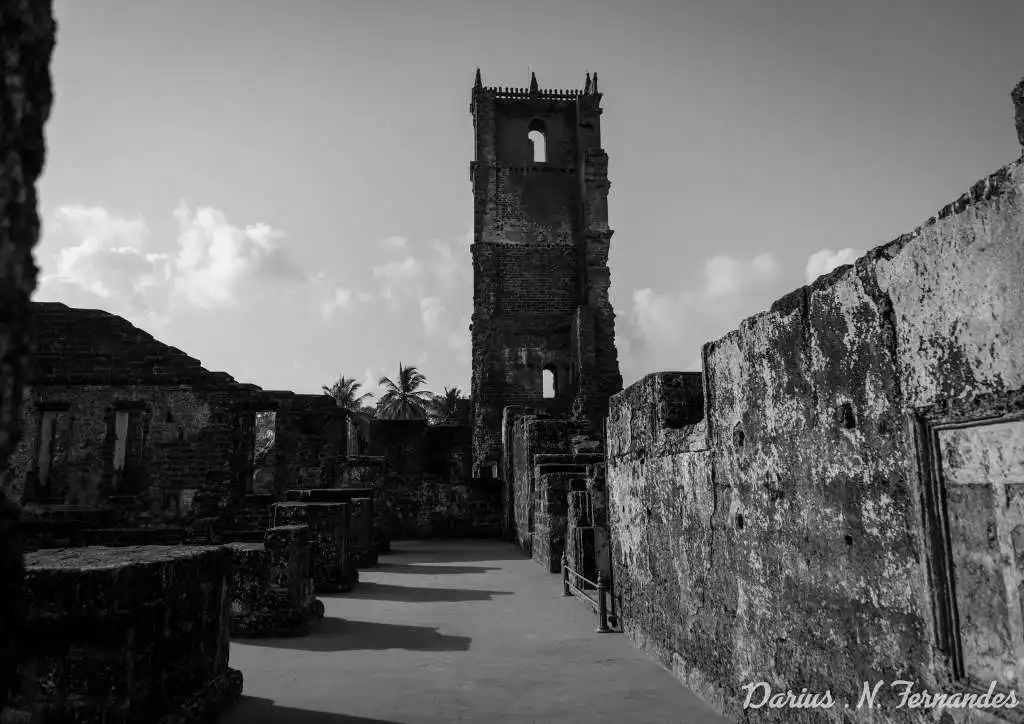How often are we guilty of not exploring our own backyard and travelling across the world in search of all that is beautiful?
Somehow, I have never really gotten down to exploring the off the grid locations in Goa. Maybe it is because I am not around or maybe because whenever we do spend time in Goa we spend it with friends and family at home.
Since I had time on my hands, my brother Darius (who happens to be an amazing photographer) and I went out to visit the ruins of the St. Augustine Church in Old Goa. Some people will know it better as the St. Augustine tower.
The St. Augustine tower is a lesser visited part of Old Goa which has a really impressive story. It’s link ties the little state with Georgia.
This post may contain affiliate links. As an Amazon Associate, I earn a small commission from qualifying purchases at no additional cost to you. Read my disclaimer for further information.
Did You Know That The St. Augustine Church Is A UNESCO Heritage Site?
Since I love visiting UNESCO sites around the world, I was surprised when I realized that there was UNESCO site in Goa and I had never paid attention. Figures right?
The ruins of the St. Augustine Church in Old Goa are a UNESCO heritage site and is it is surprisingly not that well visited. In fact, they are a part of a group of monuments that span across Old Goa which are called the Churches and Convents of Goa.
Most of the churches get loads of tourists. Not everyone heads to the St. Augustine church. It is a rookie mistake!
Location And Getting To St. Augustine Church
The Church of St. Augustine is located in Velha Goa or as it is more popularly known, Old Goa.
Quick fact: Velha in Portuguese means Old. That’s why the two names are used synonymously. There are a number of local buses that ply between the main cities. Most people however choose to use their own transport. The other alternative is to catch a cab and head there.
St. Augustine Church And Its History
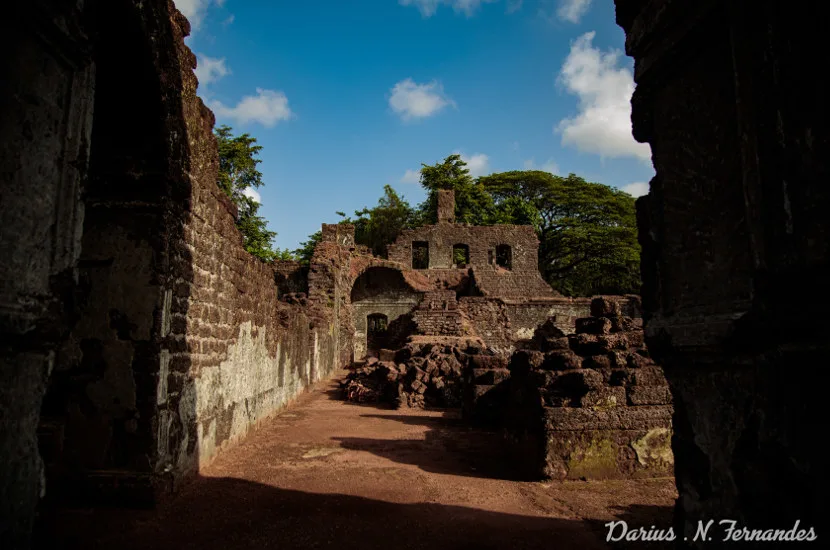
Ruins of the convent at the Church of St. Augustine.
The story of the St. Augustine Church in Old Goa goes way back to the year 1572 when the Friars of the Augustine order came to Goa and built a small convent on the hill. As time went by, this convent was enlarged until it became a three-storey building with two large stone staircases which lead to the floors above.
As soon as you entered the convent you would note two cloisters, corridors, pillars, galleries, halls with numerous rooms, a refectory (also known as a dinning hall), a guest house and an infirmary. These rooms were all very spacious.
In addition to these rooms there were also dormitories and other structures. This entire sector of the building is now in ruins.
The convent was part of St. Augustine’s church. History tells us that the college of Populo was added to the complex in 1602. Things however took an unforeseen turn when the Portuguese government of that time banned the religious order of the Augustinians in 1832.
By 1835, all the Augustinians in Goa were forced to leave. The net result was that the St. Augustine Church fell into disuse. In 1842, the huge vault of the church collapsed.
Almost a century later, in 1931, the façade of the Church of St. Augustine fell. It was followed by the fall of the towers in 1938. It may seem as if the Church of St. Augustine is not very noteworthy when in actuality, historical records show that it was the largest church complex of that time. It was also supposed to be very grand and the records of various travellers were used to prove this.
Another noteworthy point of the St. Augustine Church is the relics of the Queen Saint Ketevam, from Georgia (the country!). I will talk about her in just a bit.
What Ties Does The Church Of St. Augustine Have To Georgia?
When I say Georgia, I’m talking about the country that lies south of Russia and not the state in America. Ketevan the Martyr was the Queen of Kakheti which was a Kingdom in the eastern part of Georgia.
In 1614, Ketevan was sent by her son Teimuraz, the then King of Georgia as a negotiator in a bid to prevent the Iranian armies from invading Kakheti. It was here that she surrendered herself as a hostage to Shah Abbas.
Ketevan remained in Shiraz as a prisoner for a number of years till 1624 when Abbas I ordered the Queen to give up Christianity. When Ketevan refused, Abbas I had her tortured until she died. It was this act that gained her the title Martyr.
Part of her remains were taken by the St. Augustine Portuguese Catholic missionaries who bore witness to her martyrdom. Some of her relics made their way to the Alaverdi monastery in Georgia and some of them made their way to the St. Augustine Church in Old Goa where they remain till date.
The Ruins Of The St. Augustine Church And The St. Augustine Tower
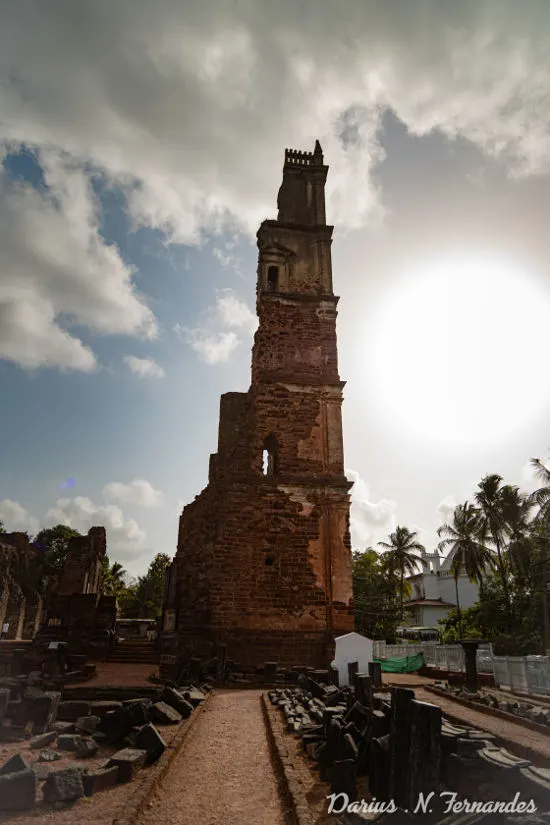
A glimpse of the St. Augustine Tower.
The reason why everyone knows the monument as the St. Augustine tower is because one part of one tower is still standing. You can see the iconic landmark from the entre of Old Goa or when you are wandering through the gardens of the Basilica of Bom Jesus or the Se Cathedral.
I think I never noticed it because we always visited Old Goa during the novenas for the feast of St. Francis Xavier and the crowds around left little time to take in the sights. That however is a story for another day. Let’s talk about the ruins of the St. Augustine church for the moment.
As you enter the complex, stop for a moment and take a peek at the boards and their descriptions of the monument. While you can see the St. Augustine tower towering ahead of you, you need to remember that it was once part of the church.
The information boards provide an image of what the façade of the Church of St. Augustine was like before it collapsed. I found it helped me visualize the whole structure better.
The Church And The Altars Of St. Augustine Church
Note that there are many ways in which you can enter the ruins. You can head in via the convent or you can head in via the main entrance. The main entrance is the part where the St. Augustine Tower stands tall on one side.
If you look closely, you will notice that a lot of the tower has been reconstructed. The main hall of the church has numerous alters on the sides. Some have plaques labelling them, others do not. Be sure to note the floors too. There are numerous inscriptions that are scattered across the hall.
The Convent
On one side of the St. Augustine Church you can walk through what remains of the convent. A part of the convent has been barricaded due to safety reasons. We noticed that there was reconstructive work underway in many spots. It was nice to see that the UNESCO monument was being looked after.
The Relics Of The Georgian Queen
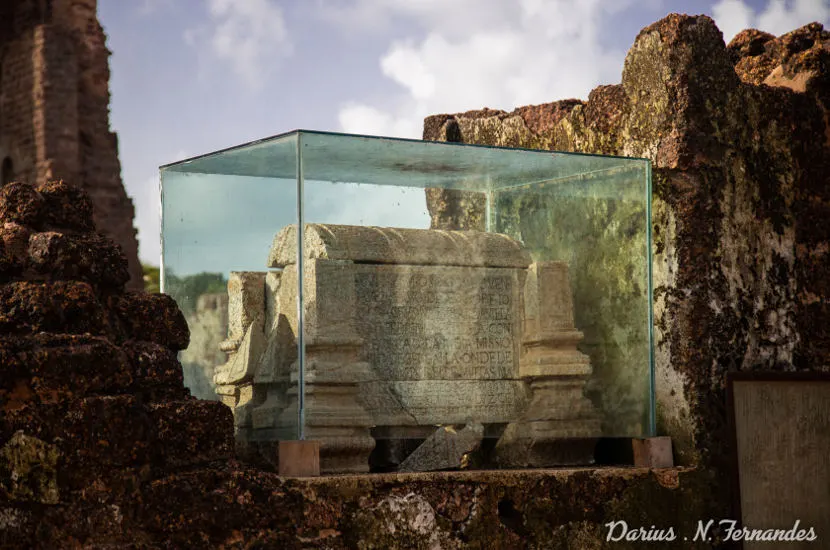
The Relics of the Georgian Queen.
You will notice that the relics of the Queen Saint Ketevan are entombed in concrete and protected by a glass box. These relics can be found in the convent area of the church. You can’t get very close to the relics since the area is cordoned off but you do get a decent view of them from below.
All in all, our day trip to see the St. Augustine Church was a fun one and one that I would highly recommend.
Tours To St. Augustine Church, Old Goa
⭐️ Rating: 5/5 (47 Reviews) Price: $19 per person Duration: 3 hours 📍Meeting Point: Church of Our Lady of the Rosary Details: Read more on Viator!
There aren’t any specific tours that go just to St. Augustine church. I would however recommend booking a tour by Soul traveling. This is one of the best tour guides in Goa. They have a tour that they call the Christian Art Trail. This trail takes you through Santa Monica, Our Lady of Rosary, the Royal chapel or St. Anthony and St. Augustine church.
It is a small group tour which is capped at 8 people. This makes it a really intimate tour and one very different to the tours conducted in Old Goa.
“Having seen the commercial side of Old Goa multiple times, I was keen on exploring off the map locations and this trail did just that. Our ambassador Joshua was an absolute delight!
With a treasure trove of fascinating insight into Goa’s past, he made this trail super fun, so much so that my friends who weren’t as keen were left asking the most number of questions by the end of it! Highly highly highly recommend this trail!”
Aishwarya (read more reviews now!)
The local tour guide will talk about the wall painting techniques, the vegetable pigments and even the origins of Goan Bebinca! If you don’t know what that is then you really have tried the Goan Christmas sweets yet!
The tour takes about 3 hours to complete and is conducted in English. The company comes highly recommended by all my fellow locals. Just book the tour in advance because they sell out super fast!
Other Posts On Goa That You Will Enjoy Reading
- Fun captions and quotes on Goa
- Great cafes in Panjim (Panaji) you should try!
- Why Padaria Prazeres should be on your list!
- Visiting Reis Magos fort from a local perspective.
- Goan Christmas sweets that you should try
On a different tangent, you may have noticed that the images have been taken by a professional photographer. Darius Fernandes is highly talented and I highly recommend using his services if you find yourself in Goa. You can take a look at some of his work on his Instagram page or contact him on +91 7743829210.
Have you been to the Church of St. Augustine in Old Goa? What was your impression of the UNESCO Heritage site? Let us know in the comments below.

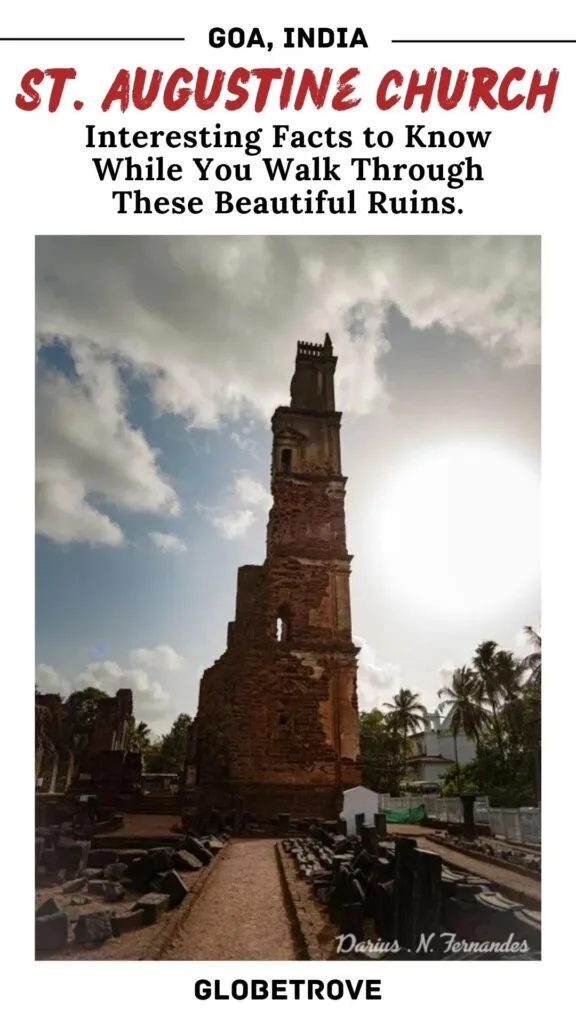
*This post contains Affiliate links

